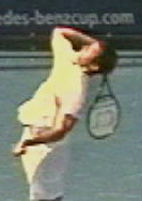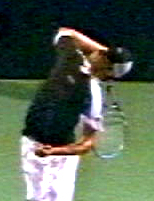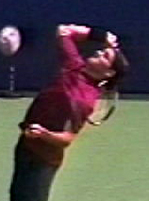
Roger Federer:
| |||||||||||||||||||||||
Roger bends the arm less and starts the bend later. |
Racket Drop
Someone with a greater knowledge of joint structure will eventually explain this fully, but for whatever exact physiological reasons, the more circular paths are much more likely to result in a good racket drop for the vast majority of players. It has to do with range of motion in the shoulder joint. As we have seen, players like Sampras and Roddick complete the backswing mainly by rotating the upper arm backwards in the shoulder joint, what is called external rotation. This is what creates that incredible racket drop position that is so characteristic of their motions.
The interesting thing about Roger is that his drop isn't as deep as either Andy or Pete. You might argue that this is actually a function of the longer backswing and that he should shorten his motion. But I think it's the opposite. What I see is that Roger's shoulder doesn't seem to be quite as superhumanly flexible. That's why I think the longer more circular wind up probably maximizes his racket drop.
| Another comparison of the racket drop. |
You can see the difference by looking at the angle of the forearm to the court at the deepest point in the drop. Roger's forearm is basically parallel to the court. Sampras and Roddick go further. By rotating the upper arm back a little further in the shoulder joint, they drop the hand a little further down. You can see the line of the forearm for these two actually drops down a little below parallel to the court. This is reflected in the actual location of the racket head which is lower and closer to the court. If Roger's armcould rotate a little further back, you probably see his positions match Pete and Andy more closely.
Now don't get me wrong, Roger has a great racket drop. The rest of us should be lucky enough to make the same position. But it's not quite as deep as Andy or Pete. Because his shoulder probably isn't quite as flexible, the more circular windup probably helps him maximize this position in his motion. And if it's true for Roger, how much more true is it for the average player?
The truth is very few players can achieve the maximum racket drop with an elbow position that is horizontal or lower. Even many pro players. You can see this exact problem in this month's Your Strokes analysis of Paul Goldstein. The problem with the abbreviated motions is that they put a premium of this component of the backswing to achieve the racket drop. Yes it would be great if most players could rotate the arm further backwards at the full drop. That could only mean more racket acceleration in the motion upward to the ball. And it's something you can probably improve by various techniques designed to increase your shoulder flexibility--strength training, stretching, deep tissue massage, etc.
 |
 |
 |
The line of the forearm indicates the amount of external rotation. |
||
But the point is to develop the best possible racket position given whatever natural ability you have. The alignment of the racket on the right side of the body with the tip pointing basically down at the pro drop position is critical. It's better to do this with a higher elbow position than not to do it at all. Otherwise you end up with the racket at a diagonal across your back when it starts to the ball. My experience shows me that the path more directly upward is absolutely critical to maximize your power and spin potential. Again, it would be great to have a deeper racket drop with the shoulder rotating even further backwards. But this racket alignment with the racket tip pointing basically down seems to maximize the effect of whatever natural rotation you really have.
| Philipoussis: a great racket drop despite, or because of, the backswing. |
But what if by a statistical miracle, I am blessed by god with that same flexible shoulder as the greatest servers? Won't I be giving away racket drop with the more circular motion? I don't think so. You can look at Philippoussis, whose motion is more circular than Federer's and see that it doesn't really seem to have a negative impact. If we look at the video, we can see that Mark's racket drop is about the same as that of Sampras or Roddick. Even with the circular backswing he achieves the same forearm position, dipping a little below parallel to the court.
So you have very little to lose and much to gain by modeling Roger's windup--or even that of Philippoussis. If video of your motion shows that you can achieve a racket drop equal to the top pros, sure, you can experiment with abbreviating the motion more. My guess is that will be 5% or even less of all players. Meanwhile, if you are in the other 95%, you will have maximized the value of the number one power source on the serve.
Arm Motion to Contact
In our analysis of Pete's serve, we identified two primary elements in the motion of the hand and racket to the ball. These are the extension of the elbow and the rotation of the hand and arm. One of the things I'm happiest about on Tennisplayer is how we are constantly increasing our knowledge of all aspects of the game, including the serve.
The extension of the elbow and rotation of the hand and arm--but what about the wrist? |
If you read Brian Gordon's groundbreaking article last month on tennis and quantitative measurement, you no doubt were fascinated by the breakdown of the contribution of the segments to racket head speed. (Click Here.) A big part of that contribution comes from the wrist. (About 25%.) And in fact we can definitely see the motion of the wrist in the high speed video. It moves from a laid back position at the drop to a neutral position at the contact. I have described this motion as giving the ball a "high 5" with the continental grip.
Brian discusses the meaning and ramifications of this in considerable detail. He concludes that that wrist motion may be at least partially driven by other components in the motion. He agrees with me--tentatively at least--that the concept of "snapping" the wrist forward is probably counterproductive in coaching.
Now in case any of you think I published that article just because Brian's science seemed to support my qualitative analysis, I have a surprise. Some of Brian's subsequent work, or so he tells me, actually indicates something different. If I understand him correctly he has found that there is definitely some active use or contraction of the muscles in the forward wrist motion. So the wrist movement is not all passive, and may even qualify as some form of "snap."
And I say great! More data is better and may lead to better understanding. I get bored just rehashing the same arguments anyway. The chance to revise your thinking is actually more stimulating This isn't a religious orthodoxy we're running here at Tennisplayer, although some coaches treat their beliefs that way and if challenged will battle to the death against the infidel.
Brian may be completely right about his revised view of the wrist, and knowing Brian he probably is. We'll let him speak for himself when he is ready on that one. But what I will stand behind is the concept of position analysis in looking at this complex motion (and all the other complex motions in tennis for that matter.) The high speed video shows the critical role of the forearm extension and the hand and arm rotation in taking the racket to the ball. ccording to Brian's analysis right before contact the elbow extension contributes about 35% of the racket head speed, and the combined rotation of the hand and arm adds another 22%. As these two key motions are happening the wrist is also moving from the laid back to the square position, accounting for it 's own 24%.
Is it a matter of what muscles--or what positions? |
The problem isn't with the wrist movement per se. The problem is with the teaching concept of the forward wrist "snap." In my opinion, this gives players the wrong image of the actual path of the hand and racket.
If we look at the motion we can see that after contact the hand and arm continue to rotate in a counterclock wise fashion. This part of the motion has come to be described as "pronation" although it's really just part of a continuum of the rotations that begin when the racket starts upward to the ball. After the contact, the arm and racket continue to rotate or prontate. As they do, they stay in a virtually straight line. This means the racket face is in line with the arm and you can draw a straight line outward from the shoulder to the tip of the racket. There isn't a forward break of the wrist at the contact or in the following part of the motion. This wrist break occurs, to the extent it happens (and it doesn't always happen) well out into the followthrough when the hand is already coming down.
Watch the hand arm and racket rotate and stay in line. |
This observation of the actual position of the hand in the high speed footage was the basis for challenging the common serving tip: "snap the wrist" for power and spin. In my experience, players who were actually able to follow this advice, and snap the wrist dramatically forward after contact tended to significantly alter the shape of the motion. If you watch Roger, as his arm and racket continue to rotate they also move forward but also from his left to his right. They reach an angle of about 45 degrees to the baseline before coming down and back across the body to his left. Players who"snap" or try to snap lack this sweeping left to right motion. Instead the motion breaks off sharply in front of them, usually with a restricted followthrough. The whole thing usually looks tight and forced.
There are really two separate issues here to consider. The firstissue is what the biomechanical components of the motion really are, their quantitative positions in space and time, and their contributions to racket head speed. This is the important, groundbreaking work that Brian and a handful of other researchers like Bruce Elliot are doing. The second issue is how to make this happen. This has been the focus of my work in high speed filming. My assumption is that if you can help a player match the physical positions in a great technical motion, then you are probably helping that player maximize the efficiency and the effectiveness of his own stroke.
More data can only help us understand the key positions. |
The quantitative approach developed by Brian can only help us all in our
efforts to define model technical positions more clearly. But what happens and how it
happens can be separate issues. This is where the art of coaching comes in. The movement
of the wrist contributes to racket head speed no doubt. The question is how to help a
player create a motion that naturally includes this, as well as the other equally important,
or even more important, parts of the motion. Different players will definitely respond
better to different input and to different coaches in their efforts to achieve this.
I don't think we have to worry that the debates about how best to do this will be
definitively settled in the immediate future.
So that's it for Part 1. Stay tuned for next month. We take a look at
the other aspects of Roger's motion that are equally good models for other
players: the tossing motion, his use of the legs, his body rotation,
and the followthrough and finish of the swing.
|
Contact Tennisplayer directly: jyandell@tennisplayer.net
Copyright Tennisplayer 2005. All Rights Reserved.
